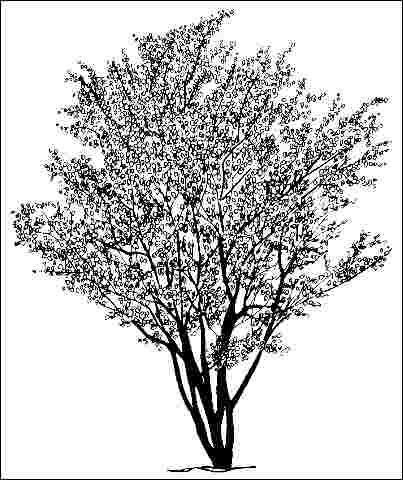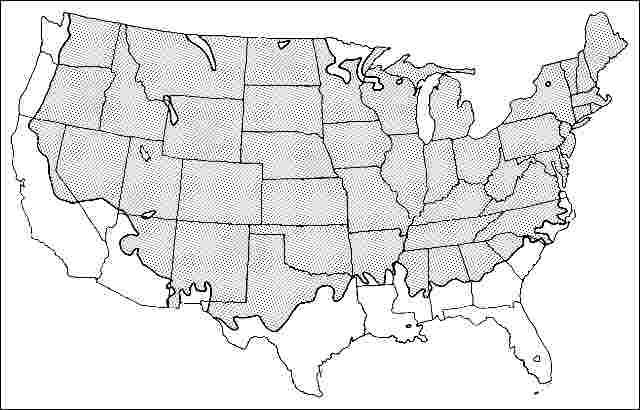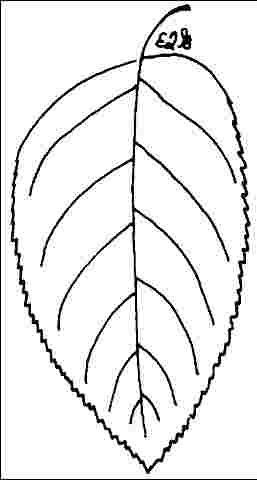Introduction
Apple serviceberry is a hybrid between Amelanchier canadensis and Amelanchier laevis that grows 15 to 25 feet tall. Its multiple stems are upright and highly branched, forming a dense shrub, or if properly pruned in the nursery, a small tree. It is superior to the species in that it suckers less and is adapted to a wide range of soils, but tolerates some drought. This cultivar supposedly resists leaf spot better than the original hybrid. The main ornamental feature is the spectacular white flowers that are larger than those of other amelanchiers. The flowers are borne in early spring and are at first tinged with pink but later fade to white. The young leaves are purplish and the fall color is red, yellow, or orange. Its edible fruit attracts birds. It is well adapted for planting along residential streets where there is plenty of soil space beneath power lines.

General Information
Scientific name: Amelanchier x grandiflora
Pronunciation: am-meh-LANG-kee-er x gran-dih-FLOR-uh
Common name(s): 'Autumn Brilliance' apple serviceberry
Family: Rosaceae
USDA hardiness zones: 3B through 7B (Figure 2)
Origin: not native to North America
Invasive potential: not assessed/incomplete assessment
Uses: container or planter; highway median; street without sidewalk; deck or patio; specimen; tree lawn 3–4 feet wide; tree lawn 4–6 feet wide; tree lawn > 6 ft. wide

Description
Height: 15 to 25 feet
Spread: 15 to 25 feet
Crown uniformity: symmetrical
Crown shape: upright/erect, vase
Crown density: moderate
Growth rate: slow
Texture: fine
Foliage
Leaf arrangement: alternate (Figure 3)
Leaf type: simple
Leaf margin: serrate
Leaf shape: elliptic (oval), oblong
Leaf venation: pinnate
Leaf type and persistence: deciduous
Leaf blade length: less than 2 inches, 2 to 4 inches
Leaf color: green
Fall color: red, orange
Fall characteristic: showy

Flower
Flower color: white/cream/gray
Flower characteristics: very showy
Fruit
Fruit shape: round
Fruit length: less than 0.5 inch
Fruit covering: fleshy
Fruit color: red
Fruit characteristics: attracts birds; showy; fruit/leaves not a litter problem
Trunk and Branches
Trunk/bark/branches: branches don't droop; showy; typically multi-trunked; thorns
Pruning requirement: little required
Breakage: resistant
Current year twig color: brown
Current year twig thickness: thin
Wood specific gravity: unknown
Culture
Light requirement: full sun, partial sun or partial shade
Soil tolerances: clay; sand; loam; acidic; well-drained
Drought tolerance: moderate
Aerosol salt tolerance: moderate
Other
Roots: not a problem
Winter interest: no
Outstanding tree: yes
Ozone sensitivity: unknown
Verticillium wilt susceptibility: unknown
Pest resistance: sensitive to pests/diseases
Use and Management
'Robin Hill' has an upright, tree-form growth habit, 20 to 25 feet tall, but is sensitive to drought.
Pests
Cambium miners cause concern when noticed but are not very damaging to the tree. The mines can extend from a twig all the way down to the roots. The mines are light colored lines in the bark. No controls are suggested.
A leaf miner will mine leaves, particularly the lower half of the leaf. The mines are irregular in shape.
The leaves of amelanchier are skeletonized by at least two insects. The first insect forms small cocoons on the undersides of leaves. Skeletonized leaves look as though they have windows in them after the insects scrape tissue off the top and bottom of the leaves. The second insect is the larva of the pear sawfly. The larvae are black to greenish black and look slimy. Adult sawflies lay eggs in May and June and again in August. Heavily skeletonized leaves drop off.
Several borers attack amelanchier. Healthy trees are considered less susceptible, so regular fertilization and watering during dry spells will help prevent borer attacks.
Spider mites will feed on amelanchier. These insects are hard to detect as they are so small. The main symptom of mite injury is the loss of green leaf coloration. If the infestation is heavy, very fine webbing may be seen. Horticultural oil sprays help control mite infestations.
Aphids of several types suck juices from amelanchier. Heavy infestations cause distortion of the foliage and new growth, and deposit large amounts of sticky honeydew on lower foliage. Black sooty mold will grow on the honeydew.
Diseases
Witches' broom, also called black mildew, infects the growing point causing the formation of many stems. The cluster of stems is called the "witches' broom". Another symptom is a black fungal growth, coating the undersides of the leaves. The damage to the tree is usually not serious and the brooms can be pruned off. No chemical controls are suggested.
Leaf blight can cause leaf drop when a severe infection occurs. The disease causes small purple spots on the leaves. The spots enlarge and turn brown, later a small black dot will be seen in the center of the spot. Large numbers of spots cause infected leaves to drop.
Fire blight is characterized by the sudden wilting and death of branch tips. The blossoms wilt, blacken, and hang on the twig. The bark is shriveled and has small bumps or blisters on it. Sometimes gum oozes out of the infected area and a crack forms between the diseased and healthy bark. Control with chemicals is difficult. Diseased branches should be pruned out. Make the cut at least four inches beyond the diseased area. Disinfect pruning tools with bleach between cuts. Fertilizing heavily with nitrogen increases susceptibility to fire blight.
Powdery mildews of several types cause white powdery growth on the leaves of amelanchier. Late in the season no controls may be needed.
Fruit rot may be a problem in wet weather. The fruits are often eaten by birds so may not be around long enough to become diseased.
Cedar rusts can be troublesome.